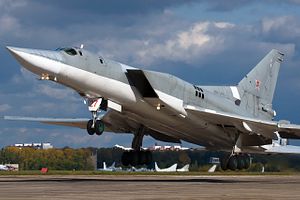A2/AD is not new.
This statement is true in the broadest possible sense — the Carthaginians took elaborate and effective steps to hold Roman fleets at bay, for example — but also in the much narrower sense of the modern military problems associated with protecting and defeating a carrier battle group. A recent set of posts at the maritime blog Information Dissemination, building on information revealed in a 2014 Naval War College Review article, highlights the ongoing dilemmas of the anti-access fight.
The Tu-22M Backfire bomber entered service in 1972, with the Soviets eventually producing almost 500 aircraft. Theories about the plane abounded (some argued that it represented the USSR’s most serious foray into a strategic nuclear bomber force), but eventually it became clear that the most important use for the bomber would come as a maritime strike aircraft. The Backfire gave the Soviet Navy a supersonic aircraft that it could use in mass to fire anti-surface missiles against U.S. carrier battle groups.
Developing the weapons that could kill, and the bombers to carry those weapons, was only part of the problem, however. The article and the commentaries on it concentrate on the critical issues of locating and correctly identifying targets. Vectoring a massive flight of Backfire bombers onto a carrier group was an enormously expensive undertaking, both in terms of opportunity cost and in likely casualties. The Soviets had to make certain where the carriers were in operational terms, and that their missile would find the carriers themselves instead of decoy vessels. The Soviets had access to some satellite data, but largely depended on surface ships and pathfinder aircraft to communicate locations and dispositions.
On the American side, the biggest problem became disrupting the Soviet system of surveillance and target acquisition. The USN practiced a variety of different methods of deceiving Soviet recon, with the goal of pushing the Soviets toward wasting resources on phantoms (not to mention exposing themselves to attack). The Soviets countered this by developing methods of their own designed to deceive U.S. carrier battle groups with respect to strength and vector of attack.
Unsurprisingly, the series is replete with lessons for the modern A2/AD confrontation between China and the United States. The article suggests that the Soviets dedicated more time to studying U.S. Navy practice than the PLAN has thus far been able to commit. The Soviet Navy was a global force that could constantly track U.S. naval movements; the PLAN remains primarily a regional force with some global aspirations. The proliferation of open-source media about U.S. naval disposition and practice could serve to ameliorate this problem to some extent, but as of now the PRC has yet to commit the enormous resources to naval competition that the Soviet military enjoyed in the 1970s and 1980s.
In particular, China has yet to construct anything along the lines of the huge, long-range, supersonic Backfire force that the Soviets developed in the 1980s. On the other hand, China has developed far more robust supporting forces, including the submarine, cruise missile, and ASBM units that complicate the defense problem for the United States. These supporting forces, operating with modern communications and reconnaissance technology, also help provide a clearer picture of the battlespace. Yet the entire system is subject to the same problems of identification, targeting, and deception as the system that the Soviets built around the Tu-22M in the 1970s.

































